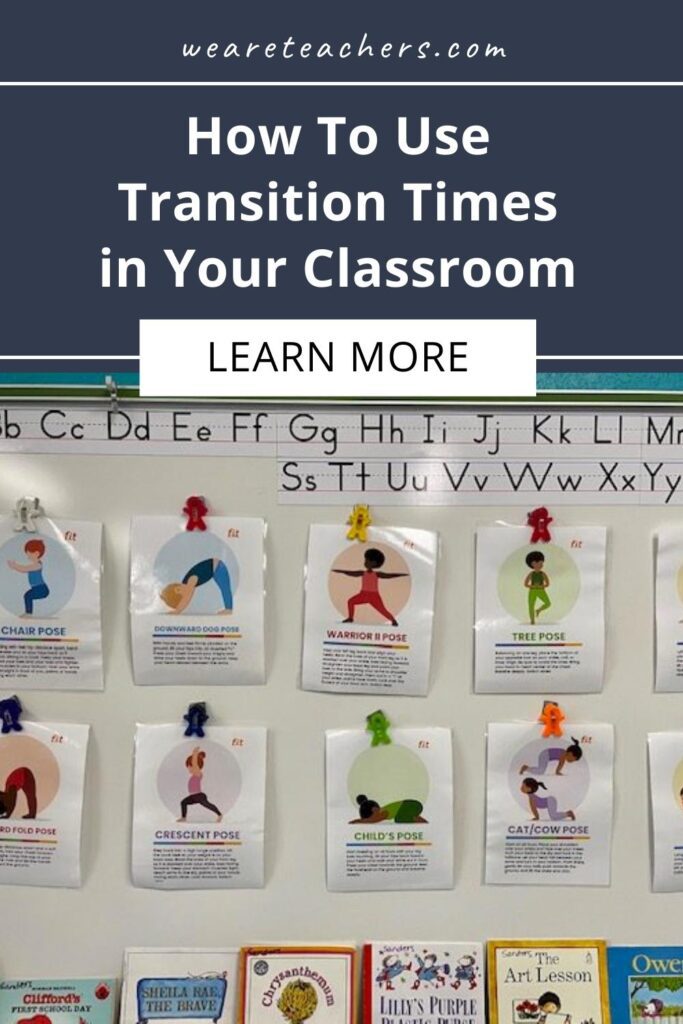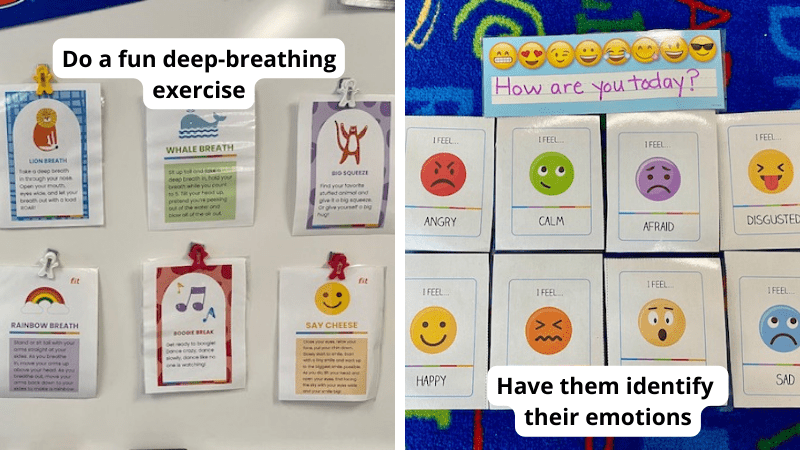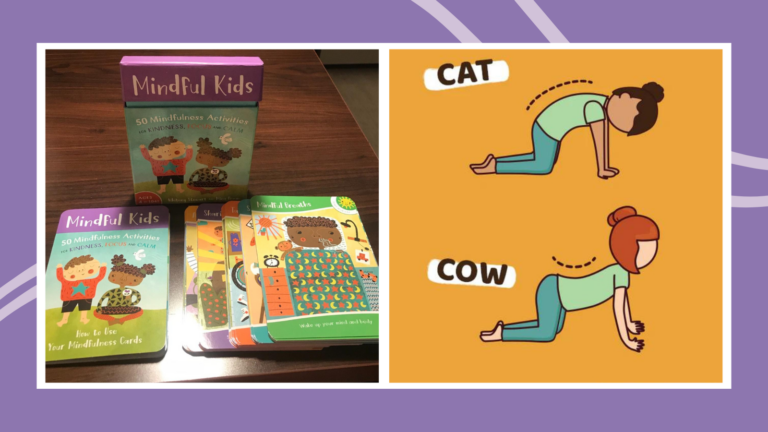Transitions are a big part of the school day. When I first started teaching 19 years ago, I was surprised by just how much time it takes to get ready for specials or to bring students back from centers. It’s hard not to feel like that’s lost time. That’s why using transition time for mental health check-ins is such a game changer. Mental health check-ins can help students get in touch with their emotions, refresh and recharge, acknowledge and cope with negative thoughts and overwhelming feelings, and be more focused throughout the day.
I find it super beneficial to incorporate quick mental and emotional health check-ins with my students as a regular part of my classroom routine. These breaks include yoga and breathing exercises. The activities I use have helped me throughout my lifetime, so I love sharing them with my students. But you don’t have to be an expert yogi or meditation master to incorporate them into your routine! Here are some ideas to try.
Choose a pose a week to do when transitioning from seat work
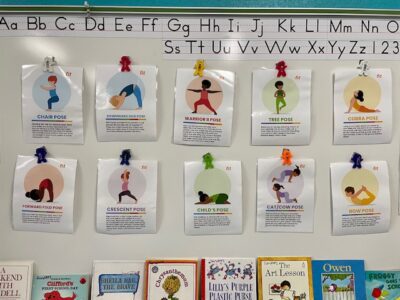
I have been practicing yoga for over 20 years, so I love to lead my students through a quick pose or a nice body stretch. (Remember that movement/stretches are good brain breaks even if we don’t call it yoga!). I find it especially helpful after students have been working independently at their seats for a while. Yoga is the perfect break before transitioning to review the assignment or another activity.
I do many of the basic poses found on these cool printables by Sanford fit. I find it helpful to display and review these visuals with my students, especially since most are new to yoga.
Do a deep-breathing exercise before read-aloud time
Taking a moment from my day to simply breathe deeply for a few minutes is another tool I use when I am stressed or overwhelmed. It is also a great technique to use with my students anytime they get a little too rowdy, especially when transitioning from their seats to the carpet for a read-aloud. It curbs the sudden hyperactivity and chitchat every time! If I need something quick, I automatically turn to a simple exercise where I have my students close their eyes (no peeking!) and take three deep breaths together, complete with exaggerated breaths in and sighs out. They giggle every time, but it works!
Pretend to breathe like an animal after an exciting activity
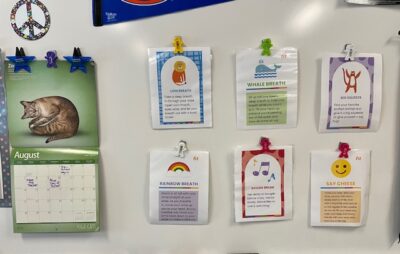
To make things more kid-friendly and fun, I draw a card from these Keep Cool or Mindful Moments cards. My students especially love the Lion Breath and Whale Breath cards, where they pretend to be those animals as they breathe. The Lion Breath card involves roaring while breathing out, while the Whale Breath card has students pretend to breathe out through a blowhole! We are even using our creativity by picking other interesting animals and acting them out through breath.
Have a five-minute dance party before heading to specials
It’s always fun to have a quick, impromptu dance party in our classroom, especially if we are already out of our seats while transitioning to the lunchroom or fine arts. The Boogie Break card gives us a chance to get the wiggles out while listening to some of our favorite music.
Shake it out after prolonged sitting
We have also been loving the “Shake Shake” technique in my classroom, where we pretend to be inside a snow globe or maraca. After shaking up our bodies, we then settle back for our next activity.
Smile big for even bigger laughs
My personal daily goal each school day is to bring laughter and smiles to all of my students. The Say Cheese card always makes everyone laugh and involves making the biggest, cheesiest smile possible. Students automatically get the warm fuzzies, and watching their classmates make funny smiles just adds to the good feelings in the room.
Try a quick emoji card check-in first thing in the morning
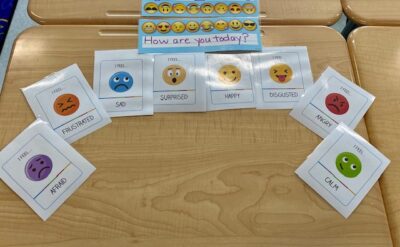
We all love emojis, and since they have become part of how we communicate electronically, kids have caught on to the trend. Besides helping convey emotion through text, they can also help children express their feelings. I like to use emoji cards during morning meeting check-in time and one-on-one conversations when I need to get to the bottom of an issue. If a student identifies an unpleasant mood or emoji, I remind them that all feelings are normal and OK—and that they will change throughout their day!
Bookmark your favorite relaxation videos
Relaxation videos are another great tool to help calm down your class and squash anxious feelings. Have your students sit down at their desks for one of these quick mental health check-ins. One of my favorites, Relax With Dakota: A Mindful Meditation for Kids, works wonders in just two minutes. It takes the mind away from worries by tensing five different areas of the body and releasing them, one at a time. My students also respond well to this 5 Senses in 5 Minutes video because it helps them feel grounded.
Line up in unique ways
Kids are VERY social and curious beings. Most of them love to chat with one another at any chance they can get. Lining up to leave the room for anything is the perfect chance for them to mix and mingle. Make a more productive use of this time by having students line up in special ways. Some fun ideas include lining up in alphabetical order by name, birth date, or height order.
Play Silent Ball when you have downtime
You can play a quick game of Silent Ball anytime or anywhere. Play a quick, three-minute game right before dismissal or before transitioning to a new activity. All you need is a small, squishy ball. The rules are simple: 1) stay quiet and 2) don’t drop the ball when passing it around. This activity builds a positive classroom community, fosters friendly competition, and boosts nonverbal communication. Enjoy the silence.
Do a mini workout before buckling down to work
Just a few minutes of movement can make a huge difference mentally. The endorphins start flowing, and your mind automatically zones in on the new activity. Worries are forgotten and now the brain is cleared and ready for something new. This five-minute full-body workout video has all the right moves for your students’ physical and mental well-being.
The takeaway …
Transitions needn’t be thrown-away time. Fitting in quick, mindful activities throughout the day gives students a mental health boost and makes those necessary transition times seamless, preparing their minds and bodies to engage in the next learning experience.
